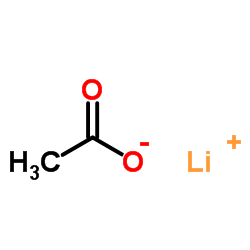Lithium acetate

Lithium acetate structure
|
Common Name | Lithium acetate | ||
|---|---|---|---|---|
| CAS Number | 546-89-4 | Molecular Weight | 65.985 | |
| Density | N/A | Boiling Point | 117.1ºC at 760 mmHg | |
| Molecular Formula | C2H3LiO2 | Melting Point | 283-285 °C(lit.) | |
| MSDS | Chinese USA | Flash Point | 40ºC | |
|
Evidence that histone H1 is dispensable for proper meiotic recombination in budding yeast.
BMC Res. Notes 8 , 275, (2015) Histone H1, referred to as the linker histone, associates with the nucleosome core particle. While there is indication that the budding yeast version of histone H1 (Hho1) contributes to regulation of chromatin structure and certain chromatin-related processes... |
|
|
Rapid high performance liquid chromatography-high resolution mass spectrometry methodology for multiple prenol lipids analysis in zebrafish embryos.
J. Chromatogr. A. 1412 , 59-66, (2015) The analysis of lipid molecules in living organism is an important step in deciphering metabolic pathways. Recently, the zebrafish has been adopted as a valuable animal model system to perform in vivo metabolomics studies, however limited methodologies and pr... |
|
|
A Single RNaseIII Domain Protein from Entamoeba histolytica Has dsRNA Cleavage Activity and Can Help Mediate RNAi Gene Silencing in a Heterologous System.
PLoS ONE 10 , e0133740, (2015) Dicer enzymes process double-stranded RNA (dsRNA) into small RNAs that target gene silencing through the RNA interference (RNAi) pathway. Dicer enzymes are complex, multi-domain RNaseIII proteins, however structural minimalism of this protein has recently eme... |
|
|
Comprehensive optimization of a single-chain variable domain antibody fragment as a targeting ligand for a cytotoxic nanoparticle.
MAbs 7(1) , 42-52, (2015) Antibody-targeted nanoparticles have the potential to significantly increase the therapeutic index of cytotoxic anti-cancer therapies by directing them to tumor cells. Using antibodies or their fragments requires careful engineering because multiple parameter... |
|
|
Potassium transporter TRH1 subunits assemble regulating root-hair elongation autonomously from the cell fate determination pathway.
Plant Sci. 231 , 131-7, (2015) Trichoblasts of trh1 plants form root-hair initiation sites that fail to undergo tip growth resulting in a tiny root-hair phenotype. TRH1 belongs to Arabidopsis KT/KUP/HAK potassium transporter family controlling root-hair growth and gravitropism. Double muta... |
|
|
Cytosolic chaperones mediate quality control of higher-order septin assembly in budding yeast.
Mol. Biol. Cell 26(7) , 1323-44, (2015) Septin hetero-oligomers polymerize into cytoskeletal filaments with essential functions in many eukaryotic cell types. Mutations within the oligomerization interface that encompasses the GTP-binding pocket of a septin (its "G interface") cause thermoinstabili... |
|
|
PABPN1 suppresses TDP-43 toxicity in ALS disease models.
Hum. Mol. Genet. 24 , 5154-73, (2015) TAR DNA-binding protein 43 (TDP-43) is a major disease protein in amyotrophic lateral sclerosis (ALS) and related neurodegenerative diseases. Both the cytoplasmic accumulation of toxic ubiquitinated and hyperphosphorylated TDP-43 fragments and the loss of nor... |
|
|
Simultaneous determination of four furostanol glycosides in rat plasma by UPLC-MS/MS and its application to PK study after oral administration of Dioscorea nipponica extracts.
J. Pharm. Biomed. Anal. 117 , 372-9, (2015) A novel, sensitive and rapid ultra-performance liquid chromatography-tandem mass spectrometric (UPLC-MS/MS) method for simultaneous quantification of four furostanol glycosides in rat plasma was established and validated. Ginsenoside Rb1 was used as an intern... |
|
|
The NG2 Proteoglycan Protects Oligodendrocyte Precursor Cells against Oxidative Stress via Interaction with OMI/HtrA2.
PLoS ONE 10 , e0137311, (2015) The NG2 proteoglycan is characteristically expressed by oligodendrocyte progenitor cells (OPC) and also by aggressive brain tumours highly resistant to chemo- and radiation therapy. Oligodendrocyte-lineage cells are particularly sensitive to stress resulting ... |
|
|
Enhancing biocompatibility of some cation selective electrodes using heparin modified bacterial cellulose.
Carbohydr. Polym. 134 , 687-94, (2015) Bacterial cellulose (BC) and heparin-modified bacterial cellulose (HBC) were utilized to enhance the biocompatibility of highly thrombogenic PVC-based potassium and calcium membrane electrodes. Three types of membrane electrodes were prepared: (1) conventiona... |